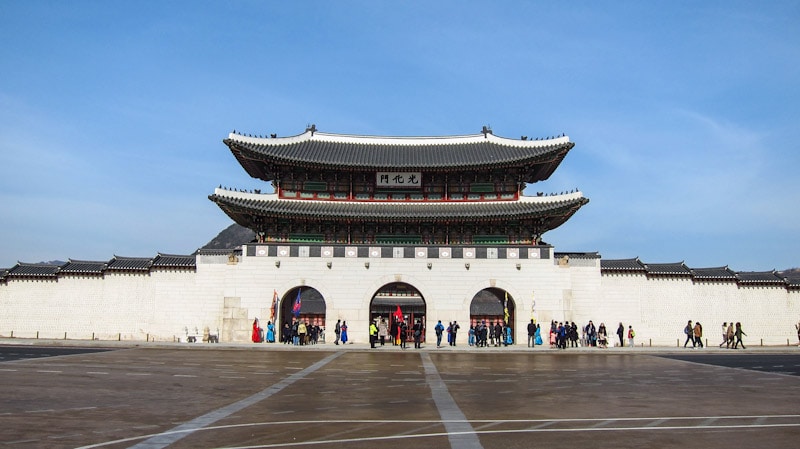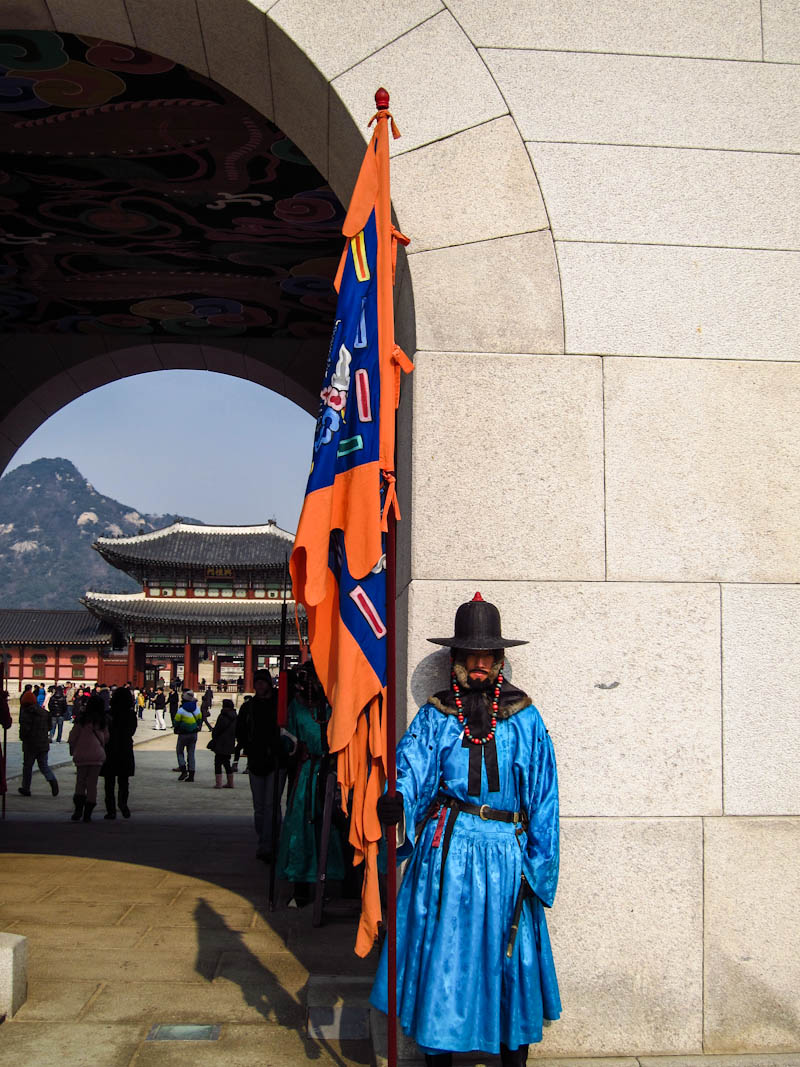
Gwanghwamun Gate is the imposing main gate of Gyeongbokgung Palace. The gate has been rebuilt many times over the years but remains an icon of Seoul.
Construction began in 1395 at the beginning of the Joseon dynasty. The gate quickly became one of the most important gates of the Joseon Dynasty since it guarded the main palace.
There are three other gates that can be found along the 2,404 meters (7,887 feet) of walls surrounding the palace. The other three gates are Sinmumun, Geonchunmun, and Yeongchumun.
The gate consists of three entrances and a towering two story pavilion. At one time, Gwanghwamun was guarded by multiple watchtowers.
In 1592, the gate was destroyed by the Japanese during their invasion of Korea during the Imjin War. In 1867, almost 250 years later, the gate was reconstructed during the reconstruction of adjacent Gyeongbokgung Palace.

In 1926, the Japanese who occupied Korea at the time, moved Gwanghwamun near the location of the present day National Folk Museum of Korea. The gate was moved to make room for the new Japanese Governor General Building, which stood at this location until its demolition in 1995.
During the Korean War, the wooden gatehouse was destroyed once again. It was rebuilt using concrete and remained this way until 2006.
In December 2006, work began to restore Gwanghwamun to its original wooden specifications. The restoration work paid special attention to historical details. On August 15, 2010, restoration work was completed at a cost of 28 billion won ($24 million).

Table of Contents
Gwanghwamun Gate Hours
24 hours
Admission
The gate is free to view and walk through. The palace requires a ticket to enter.
How to get to Gwanghwamun Gate
Gwanghwamun is located at the entrance to Gyeongbokgung Palace.
Option 1
Take Subway Line 3 to Gyeongbokgung Station (Exit 5).
Option 2
Take Subway Line 5 to Gwanghwamun Station (Exit 2).
Map
Additional Resources
Viator
Viator is a popular online platform that helps travelers book tours, activities, and unique experiences worldwide, including in Seoul. It connects users with a wide selection of options, such as sightseeing tours, cultural events, outdoor adventures, and more, all offered by local providers. Travel easily, with free cancellation and flexible payment options, making Viator an excellent choice for stress-free tour booking.
Book Recommendations
While The Seoul Guide provides plenty of information about traveling to Seoul, sometimes it helps to bring a book with you on your journey. Want to visit Gwangjang Market, hike Bukhansan National Park, visit an ancient palace, or sing karaoke all night long? The book I always recommend is Fodor's Seoul, which provides expert recommendations including sights to see, restaurant reviews, maps, and essential trip-planning information for everything related to Seoul.
Learn more about book recommendations
Rakuten
Save money while exploring Seoul with Rakuten cashback program. By booking hotels through Rakuten, visitors can earn cashback rewards and enjoy significant savings. Exclusive partnerships and deals make stays in Seoul more affordable, freeing up funds for attractions, dining, and other experiences. I use Rakuten for cashback on all of my hotel stays in Seoul.
If you sign up using the link below, you will get $30 cashback after your first purchase over $30.
Klook
Klook is a reliable online platform offering discounted tickets and reservations for attractions and services in Seoul. It covers theme parks, museums, transportation, WiFi, tours, and more. Travelers can save time and money by booking through Klook's user-friendly interface, with secure transactions and helpful customer support.
If you sign up using the link below, you will get $5 off your first order.
Learn more about KlookLast Updated on Apr 12, 2022